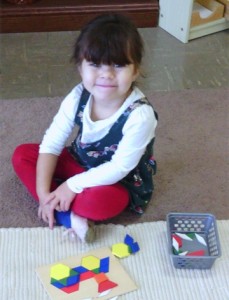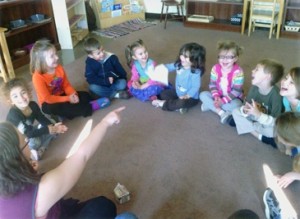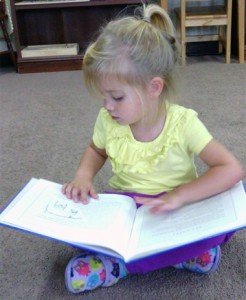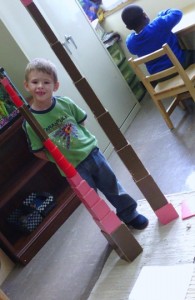Cuyahoga Falls School
The children are adapting very well to their classroom!! All of us are truly enjoying being at school. Here are a few things we are working on in the classroom. In language and vocabulary, we are learning about autumn’s changes, weather, nature, and activities. My students enjoyed observing the changing season this month and I loved talking with them about it! We are also discussed fire prevention and fire safety. While we were learning about fire prevention, children enjoyed trying new “routes” around the school, walking up the different stairways in the building to explore our safe exits. We also talked about “stop, drop and roll” and practiced putting action to those words! Students loved singing, “The Wheels on the Fire Truck.” Ask them about it I’m sure they will sing it for you!
We also talked about Halloween safety, and the concepts of real and pretend. We also enjoyed new colors in our classroom for the Month of October which gave special attention to black and orange. I also enjoyed hearing the beautiful voices of our students as we sang together a few fun filled Halloween themed songs at circle time. We also focused on the directional and positional concepts of IN and OUT. We put objects in a variety of containers, and then took them out to demonstrate the concepts of IN and OUT. We also used a variety of the Sensorial materials to reinforce the concepts of big and little.
Students were able to work on refining their fine motor skills this month while practicing with lacing, cutting, coloring, drawing, play dough manipulation making circles and path tracing. The children were also able to enhance their perception skills by learning about same and different, puzzles, sorting, and copying block and peg patterns. Gross motor activities such as organized games like musical chairs, tossing and catching and moving to the music is also enjoyed many afternoons! Students focused on where they live, learning their phone numbers, new ASL signs and also baked some very tasty items this month with Ms. Kristen in the afternoons.
Students learned and sang their own phone numbers and worked hard to memorize their address, city, county and state they live in. Together they also enjoyed the tastes of the season by making a very tasty pumpkin dip, baked pumpkin seeds and even home made butter! Students also enjoy their yoga time with Ms. Kristen. The music and the moves truly help our students relax after a hard day at work!
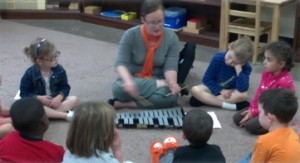
Last month I shared a bit about Practical Life in our classroom, this month I wish to focus on the Sensorial area. Every area of the Montessori classroom includes multi-sensory materials that encompass sight, smell, sound, touch, and taste. These sensorial areas of the Montessori classroom focus on educating through the senses. Dr. Montessori wrote, “Nothing comes to the intellect that is not first in the senses.” (Montessori Method). As early as the infant program, young children explore Montessori materials through their senses. The toddler environment may include knobbed cylinders which are cylinders that have a knob, but are exactly the same size, making the child successful due to the self correcting nature of the material. The 3-6 year old environment also includes knobbed cylinders but they are graded according to height, width or both to distinguish differences in these two properties.
Attention is also drawn to the totality of an objects’ properties – size, shape, color, texture, weight, smell, sound… Eventually children learn to pay attention to small details in an object and the environment, which helps them discover how to learn.
The Montessori materials help a child to distinguish, to categorize, and to relate new information to what they already know. Dr. Montessori believed that this process is the beginning of conscious knowledge: Knowledge that is brought about by the intelligence working in a concentrated way on the impressions given by the senses. The Directress assists the child in developing their learning techniques by creating a prepared environment and presenting exercises with deliberate, exact and slow movements that the child can follow. You can see how smart you are here. The Sensorial area can be further divided into sub-categories:
- Visual: pink tower, brown stair, red rods, knobbed cylinders
- Tactile: Touch boards, touch tablets, fabric boxes
- Auditory: Sound boxes, bells
- Baric: Baric tablets (differ by weight)
- Olfactory: Taste Jars
- Gustatory: Smelling Jars
An additional sub-category includes geometry. Geometry is introduced at the toddler level with shapes (circle, square, triangle, sphere, cube, prism) and further developed in the 3-6 environment and the elementary classrooms. The children are introduced to what they know first, plane figures. We begin with the triangle, square and circle. Once a child masters these basic plane figures, additional ones are introduced. Then a child can find different plane figures in the environment. Once solids are introduced, a child can match a solid figure with its base. The sensorial area of the environment is one that naturally draws children to it so each child can explore and further develop their potential through the senses.
As I was reading the Ohio Department of Education standards for preschool learning and what is expected in grade K, I was amazed to find that the Sensorial area helps the child meet and exceed their ma thematic requirements, such as number, number sense and operations, measurement, geometry and spatial sense, patterns, functions and algebra, as well as, data analysis and probability!
The Sensorial area builds up the child’s Mathematical Mind, as Dr. Montessori discovered. Just imagine what the Math area of our classroom can do for our children in meeting those same standards. Therefore, next time when you hear that your child builds with the Pink Tower and the Brown Stair, or worked with the Red Rods among others, rejoice! The website of the Ohio Department of Education is www.OhioAcademicStandards.com
Activities for the Home:
Keep your child moving to help them develop their senses. It is through movement that babies first learn to crawl, walk, and then run! Allow your child to walk (safely) on the flower bed wall. This encourages your child to develop a sense of balance and to become aware of them self. Let them jump, hop, skip… while playing games or outside. Take walks often – whether you live in an urban, suburban or other environment there are always things to see and do. Go on a sensory walk – listen for sounds or smells in your environment and point out smells and sounds that change with the different seasons. Your goal is to help heighten your child’s awareness and it is a wonderful opportunity to bond with your child. A walk can be around the block or a long hike. Let your child be the guide in terms of when they are finished or how long they want to continue. Keep sensory activities active. Video and computer games can be very sensory (especially visual and auditory) in nature, but limit the amount of time your child spends on this type of activity, even when there are good games as Overwatch that kids can play, and learn what to play in overwatch so they use their mind. Video and computer games tend to be very sedentary. Visit a new playground in your area. Find out where your community has handicap accessible playgrounds. Often, these playgrounds have equipment for blind or otherwise special needs children. These playgrounds provide a great opportunity for your child to learn about other children and their needs and the opportunity to play with something that might be new, the good thing about these playgrounds is that they get constant playground maintenance, so they are in great condition!

